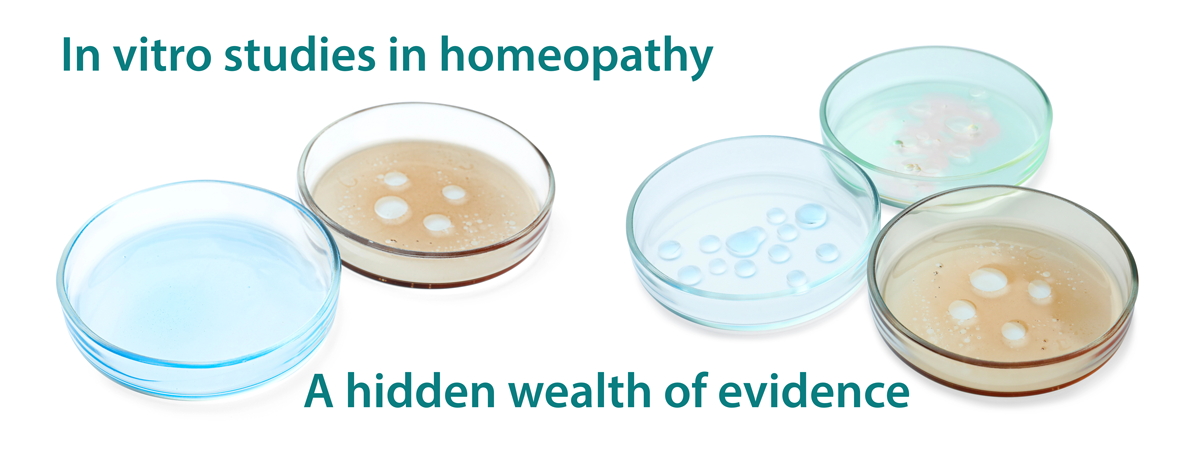A growing body of in vitro research tells an interesting story, one that’s often overlooked amongst the claims that there is “no scientific evidence” for homeopathy.
In vitro studies are experiments conducted in test tubes or petri dishes, often using cells, tissues, or plants. What makes them particularly valuable in homeopathy research is their ability to detect biological effects without placebo influence. Many of these studies follow rigorous scientific protocols and use modern analytical methods.
Let’s take a closer look at what the evidence actually shows: A systematic review
A major milestone in this field came in 2007, when Professor Claudia Witt and her team from Charité University Medical Center in Berlin, reviewed in vitro studies using homeopathy. Publications of experiments were collected through databases, from experts, previous reviews and citation tracking. The aim was to search all appropriate databases for relevant studies, determine which studies met the quality criteria set by the researchers, and then to determine which, if any of these, exhibited a statistically significant effect in this area. Their systematic review identified over 50 high-quality studies, and many demonstrated biological effects of high-potency remedies. Examples of these studies are as follows.
Gelsemium: Reproducible effects on nerve cells
Gelsemium sempervirens is a traditional medicinal plant. It has long been used as a homeopathic remedy for a variety of symptoms listed in materia medica such as neurological and behavioural symptoms, including general prostration, drowsiness, tiredness, mental apathy, lack of muscular coordination, anxiety, and depression. The onset and development of anxiety and depression are affected by the neural plasticity of the brain. Neural plasticity, or neuroplasticity, is the brain’s ability to change its structure and the way it functions in response to external and internal stimuli. One key aspect of neuroplasticity is neurite outgrowth, the process by which developing neurons extend and form connections. Healthy neurite growth supports learning, memory, and emotional balance.
When considering research on the actions of the remedy Gelsemium it is also interesting to remember that our brain cells rely heavily on mitochondria, the tiny energy centers within each cell. These structures produce energy (ATP) and help regulate cell survival, repair, and communication between neurons. When mitochondrial function or neuroplasticity is impaired, it can contribute to a range of mental health challenges.
Because the traditional effects of Gelsemium in the treatment of anxiety is well documented, researchers began exploring its effect in vitro using homeopathic preparations. These studies have looked at whether Gelsemium can improve key bioenergetic processes such as ATP production, mitochondrial respiration, cellular glycolysis (energy generation), and neurite outgrowth.
Repeatedly in vitro studies have shown promising results, including:
- Increased energy production (ATP, mitochondrial activity, glycolysis) in human nerve cells
- Enhanced nerve regeneration, boosting growth and connectivity of immature nerve cells
- Protection from cellular stress, potentially relevant to aging and cancer.
These findings open up possibilities for understanding how homeopathic remedies might interact with cellular energy systems and brain health, an area that continues to inspire further investigation.
In 2011, scientists at France’s University of Strasbourg built on previous work done on Gelsemium. They exposed rat limbic and spinal cord tissue to 5c, 9c and 15c homeopathic preparations of Gelsemium and gelsemine (one of Gelsemium’s active constituents) to determine their effects on pain and anxiety at a cellular level. During this process it was shown that the 5c potencies of both remedies, and to a lesser extent the 9c potencies of both remedies, increased the conversion of progesterone to allopregnanolone in these tissues. Allopregnanolone is a potent modulator of the GABA-A receptor and is known to play a role in anxiety and pain modulation. The study suggests that the increase in allopregnanolone production may be the basis for the analgesic and anxiolytic effects observed with Gelsemium.
In 2022, similar effects were observed using the potencies 3C, 5C, and 15C, and replicated across multiple independent labs.

Figure 4 from the 2022 study shows the Gelsemium images 3c and 5c are highly significantly different to the controls CNTRL and NGF P<0.001)
In 2025, the most recent study on this topic, it was found that Gelsemium has neuroprotective effects against stress-induced cellular changes in the brain by regulating mitochondrial functions, essential for the survival, plasticity, and function of neurons.
Gunpowder’s antimicrobial potential
In 2025, in vitro research explored the potential antimicrobial effects of homeopathic Gunpowder remedies 6c and 30c. Using recognised laboratory techniques, including microdilution and disk diffusion assays, researchers tested these remedies against Staphylococcus aureus, a bacteria associated with antibiotic-resistant infections. The tests compared Gunpowder 6c and 30c with both a standard antibiotic (gentamycin) and a negative control (ethanol) to measure their relative activity.
The results showed that both Gunpowder 6c and 30c produced clear zones of inhibition against S. aureus, suggesting measurable antimicrobial activity. While gentamycin showed the strongest effect, the homeopathic preparations demonstrated significant results compared to the control, with consistent findings across repeated experiments. These outcomes suggest that Gunpowder 6c and 30c may have potential as supportive or complementary approaches in managing conditions related to antimicrobial resistance.
Plant based experiments: Duckweed
A 2022 laboratory based experiment from the University of Bern, Switzerland showed that homeopathic Arsenicum album helped duckweed plants which had been “stressed” (slightly poisoned) to recover.
Duckweed is a small, aquatic plant also known as water lentils. It is extremely sensitive to tiny amounts of impurities. For this reason, it is often used for water quality tests. Lemna gibba L., commonly called Duckweed, is a small, floating aquatic plant found in ponds and lakes. It has oval leaves that measure 3–5 mm and has a single root hanging into the water. Mild poisoning with arsenic causes growth disorders and structural changes – both of which can be easily observed and measured.

Lemna gibba L. commonly called Duckweed (the small leaves in between the larger water lily leaves)
In this 2022 study by Ücker et al., the duckweed was first stressed with arsenic at concentrations which significantly inhibited plant growth, but did not prevent the duckweed from recovering. The plants were then treated with homeopathic Arsenicum and randomised into two groups, one treated with Arsenicum and the other control group receiving only water. The study found that treatment with Arsenicum led to a significant increase in growth compared to the control group and it brought the duckweed back to a healthier state.
The study found that the plants exposed to higher arsenic concentrations responded more to the homeopathic treatment than those that were less damaged. This was reflected in a significant improvement in growth rate compared to the control group, which was detectable three to nine days after exposure to the homeopathic remedies.
The study used high-quality experimental design and statistical methods to ensure that the results were not false positives. To rule out the possibility that the results were simply due to chance, or any other external factor which could influence the results, a sequence of five independent individual experiments was conducted twice, with each experiment being blinded and randomised.
This study is of particular importance because it replicates an earlier study by Jäger et al. in 2010 which increases the reliability of the findings, further eliminating the possibility that the results occurred by chance, confirming that duckweed poisoned with arsenic, responds to treatment with homeopathic Arsenicum and provides further scientific evidence that homeopathic medicines have specific biological effects.
In 2021, other plant-based studies showed similar effects using Mercury stress models and have been replicated successfully.
More studies: Bulls, basophils and fungi
Here’s a sample of the wide-ranging in vitro homeopathy research done to date:
- Bull sperm: One marker of sperm health is mitochondrial activity eg: sperm motility and in laboratories monensin is commonly used as an inhibitor for sperm mitochondrial activity. The researchers in this 2005 study examined the effects of the 5X to the 14X homeopathic potencies of Monensin on the activity of the mitochondria of sperm taken from mature bulls. All of the potencies produced a stimulatory effect on the bull sperm mitochondrial activity, with the 9X producing the strongest of these effects.
- Human basophils: Homeopathic Histamine inhibited allergic-type reactions in blinded studies in 2004 across four labs.
- Renal cells: Material concentrations of cadmium have strong toxic effects on renal tubules. In 1994, Delbancut et al. found that pre-treatment with homeopathic Cadmium 40x, and subsequent exposure to material concentrations of cadmium, led to a significant reduction in cadmium induced damage in kidney cell cultures.
- Immune cells: As far back as 1982, laboratory measurements of guinea pig macrophages and human leucocytes exposed to the homeopathic remedies Belladonna, Hepar sulph, Pyrogenium, Silica and Staphylococcinum, showed that these remedies produce an increase in immune competence. They were able to stimulate macrophage and leucocyte activity, suggesting a boost to immune response.
- Fungal infections: In 2002, it was investigated whether or not homeopathically prepared Thuja occidentalis has an in-vitro fungicidal effect on pathogenic Aspergillus niger and flavus. Pathogenic strains of these organisms were grown by standard laboratory means and were exposed to Thuja 30c, 200c, 1M, 10M and 50M as well as two negative controls (water and ethanol) and a positive control (Ketaconazole). After incubation the cultures were measured to determine the extent of growth inhibition, sporulation, and exudation of the fungi. All of the Thuja potencies showed some effect against both species of aspergillus, but when compared to the negative controls, the 30c and 200c potencies showed the greatest effect achieving more than 70% growth inhibition compared to sterile water control. In addition, the 30c potency proved to have a 93% equivalence to Ketoconazole and the 200c exhibited an 89% equivalence. For Aspergillus niger, Thuja 50M demonstrated significant antifungal activity, comparable to the allopathic drug ketoconazole, with a colony diameter of 2.2 mm on the 9th day of post-inoculation.
- Parasites: Trypanosoma cruzi 30x reduced parasite levels and mortality in infected mice, confirming an effect on specific IgM and IgG antibody production. Pre-treatment with the Trypanosoma cruzi 30X was associated with a 50% reduction in mortality, an increase in specific antibody and a reduction in the numbers of the parasite in the blood of mice infected with this organism. The study by Queiroz et al. was conducted in 2006.
- Histamine response: Homeopathic Histamine in multiple potencies 2c, 12c, 14c, 15c and 16c inhibited basophil activation, replicating and therefore strengthened previous findings. This is one of quite a few studies that have been carried out to investigate the action of homeopathic Histamine on human basophils.
So What Does This All Mean?
There is a rich and growing body of scientific evidence showing that homeopathic medicine can produce measurable biological effects in cells, plants, and tissues. These studies are conducted in mainstream universities, published in peer-reviewed journals, and follow strict scientific standards.
These findings demonstrate reproducible biological activity.
Final Thought
In vitro studies offer a powerful way to investigate homeopathy. While the exact mechanism of action remains a topic of ongoing exploration, the evidence base is far more substantial than critics often admit.
The next time someone says “there’s no evidence,” feel free to share this blog with them.

